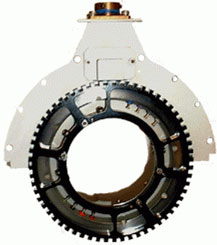The tubular slip ring assembly with an optional encoder is particularly useful for drive shaft measurement applications where both torque and thrust measurements are needed.
Features
- 8 circuit slip rings
- Compact design
- Mounts on shafts up to 2″ in diameter
- Permanently lubricated bearings
- Rugged stainless steel construction
- Instrumentation quality rings and brushes
- Optional 60 pulse per revolution encoder option
Description
Michigan Scientific’s B Series Slip Ring Assemblies are ideal for applications that require the slip ring to be mounted directly on a rotating shaft. Typically used for automotive drive shaft measurement applications, they are designed to fit on shafts up to 2” in diameter and make an electrical connection to strain gages, thermocouples, or other sensors that have been installed on rotating equipment. The slip ring brushes and rings are made of precious metals, which minimize noise and enable the assemblies to be used for low level instrumentation signals.
The tubular slip ring assembly with an optical encoder is particularly useful for drive shaft applications where both torque and thrust measurements are needed. In addition, they provide enough circuit connections for measuring up to five amplified strain gage or thermocouple signals. Michigan Scientific’s precision strain gage and thermocouple amplifiers, positioned on the rotation side of the slip ring, greatly improve signal quality. They reduce the amount of errors due to long lead wires, connector resistance variations, electromagnetic interference, and temperature gradients across slip ring contacts.
Connections are made through color coded solder terminals located on the slip ring rotor and a connector on the slip ring stator. Each slip ring assembly includes a 15 ft. cable with a single mating connector attached. The compact-width design of these slip rings make them ideal for applications where limited space is available.
The encoder included in the tubular slip ring assembly produces a 60 pulse/revolution 5-volt square wave. The TTL compatible signal is produced by a hall-effect sensor, which allows speed to be determined down to 0 rpm. The voltage required to drive the encoder can range from 5.5 to 45 DC volts.
Documents
Tech Notes
Last Modified:
